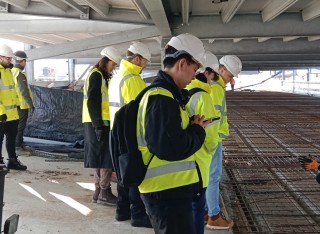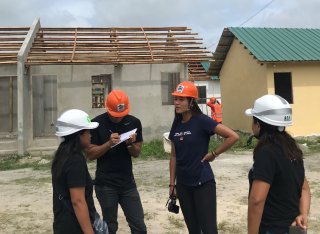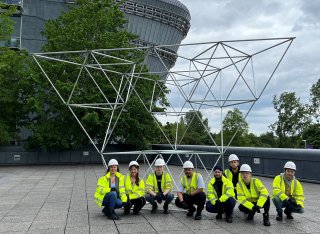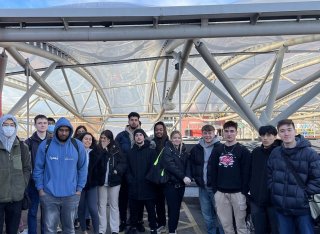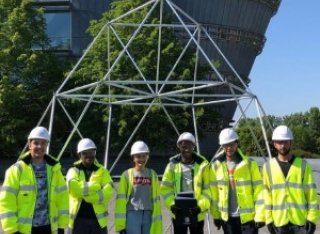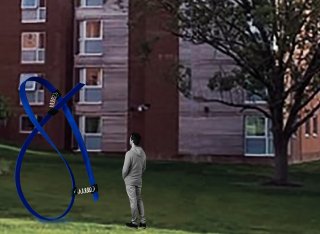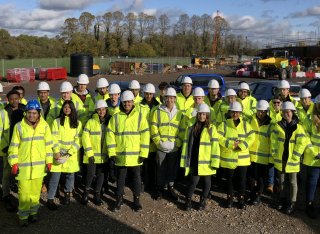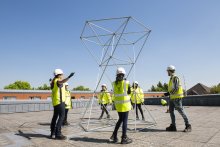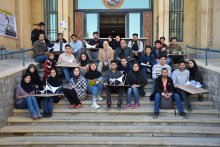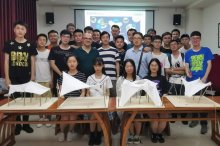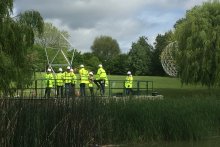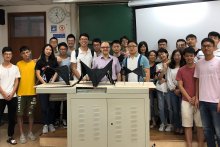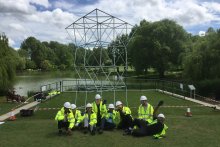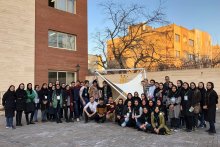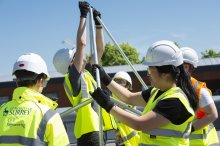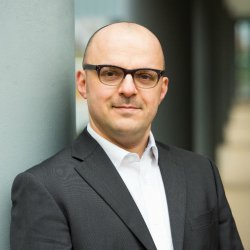
Dr S. Alireza Behnejad
About
Biography
Dr Alireza Behnejad is an Associate Professor at the Department of Civil and Environmental Engineering. He achieved his first master’s degree in architectural engineering in 2001, followed by a second MSc in Structural Engineering, a PhD in Geometry of Spatial Structures in 2018, along with a Graduate Certificate in Learning and Teaching from the University of Surrey.
Alireza is the Director of the Spatial Structures Research Centre of the University established by Prof Z S Makowski in 1963. He has also had thirteen years of experience as an Architect and Director of a company in the field of design and construction of prefabricated light weight structures, prior to joining the Centre.
Alireza received the Vice-Chancellor's Award for Teacher of the Year in 2021 due to making a significant contribution to enhancing students’ learning experience and the quality of their learning.
He is an Editor in Chief of the International Journal of Space Structures, that is a peer-reviewed journal with the aim to provide an international forum for the interchange of information on all aspects of analysis, design and construction of space structures. The Journal was established by Prof H Nooshin in 1985 and is currently being published by Sage Publishing.
Alireza was the Conference Chair and Head of Organising Committee for the Spatial Structures Conference (IASS2020/21), the first ever fully virtual symposium of the International Association for Shell and Spatial Structures (IASS) held from 23 - 27 August 2021. Alireza is a member of the Executive Council of the IASS and the founding chair of the working group on Teaching of Shell and Spatial Structures (IASS-WG20).
Areas of specialism
University roles and responsibilities
- Director of the Spatial Structures Research Centre
- Programme Leader for Undergraduate Courses in Civil Engineering
- Member of the University Ethics Committee
- Validation Panel Member - Quality Enhancement and Standards
Affiliations and memberships
News
In the media
ResearchResearch interests
- Design and Construction of Spatial Structures
- Formex Configuration Processing
- Bamboo Structures
- Engineering Education
- Regularity of Structural Forms
- Conceptual Design
- Membrane Structures
Research projects
Bamboo For Sustainable Construction and Quality of Life ImprovementThe climate emergency focuses the need to develop sustainable, carbon sequestering construction materials:
bamboo is such a material. Rapid growth, renewability, affordability, workability, and high mechanical resistance are some of the bamboo advantages. The project is geared towards extending the fundamental understanding of natural bamboo (NB) and engineered bamboo (EB), promoting their safe use in construction, and in education of the next generation of engineers in their uses who can take this knowledge into their future professional lives.
To address the challenges, the project has built an international network from four universities with complementary specialties. The international multidisciplinary partnership across engineering, agriculture & education comprises the following: University of Surrey (United Kingdom), University of São Paulo (Brazil), North Carolina State University (USA) & University of Wollongong (Australia), under the umbrella of the University Global Partnership Network (UGPN).
Alireza is the Principal Investigator for the research project to develop a full-scale membrane structure kit for educational purposes funded by Nohmura Foundation, Japan. This is in collaboration with the University of Sao Paulo, Brazil and the University of Fukui, Japan for the expansion of the use of full-scale physical models in engineering education.
Seismic Behaviour of Lattice StructuresDr Behnejad is the Co-Investigator for the research on the seismic failure load of single-layer reticulated shells based on key structural design parameters funded by the UK Royal Academy of Engineering. This is a research collaboration with the Southwest Jiaotong University in China and the aim of this project is to propose a new seismic failure criterion for single-layer reticulated shells subjected to earthquakes.
Structural Performance of BambooAlireza leads the research on the structural performance of bamboo in collaboration with Arup Company from industry and the Pontifical Catholic University of Rio de Janeiro, Brazil. The outcome of the collaboration is going to be used for the development of the codes of practice for bamboo structure design. One of Alireza’s students who has been investigating the structural behaviour of bamboo joints was nominated for two final year project awards in 2018, namely, the IStructE Prize and the Atkins Prize and he was awarded with the latter.
Educational ResearchDr Behnejad has been researching the benefits of full-scale physical models in civil/architectural engineering education, as well as the new concept of Pedagogic Frailty. Also, I am leading the research on ‘International student collaborations to achieve teaching excellence in higher education’. This is part of the Student-Staff Research Collaboration on Teaching Excellence initiated by the Department of Higher Education of the University.
Research collaborations
- University of Sao Paulo, Brazil
- North Carolina State University, USA
- University of Wollongong, Australia
- Western Institue of Technology and Higher Education, Mexico
- Ferdowsi University, Iran
- Southwest Jiaotong University, China
- University of Fukui, Japan
- Novum Structures LLC, UK
- Arup, UK
If you or your institution are interested in collaborating on the DAD project please do not hesitate to contact Alireza via email.
Research interests
- Design and Construction of Spatial Structures
- Formex Configuration Processing
- Bamboo Structures
- Engineering Education
- Regularity of Structural Forms
- Conceptual Design
- Membrane Structures
Research projects
The climate emergency focuses the need to develop sustainable, carbon sequestering construction materials:
bamboo is such a material. Rapid growth, renewability, affordability, workability, and high mechanical resistance are some of the bamboo advantages. The project is geared towards extending the fundamental understanding of natural bamboo (NB) and engineered bamboo (EB), promoting their safe use in construction, and in education of the next generation of engineers in their uses who can take this knowledge into their future professional lives.
To address the challenges, the project has built an international network from four universities with complementary specialties. The international multidisciplinary partnership across engineering, agriculture & education comprises the following: University of Surrey (United Kingdom), University of São Paulo (Brazil), North Carolina State University (USA) & University of Wollongong (Australia), under the umbrella of the University Global Partnership Network (UGPN).
Alireza is the Principal Investigator for the research project to develop a full-scale membrane structure kit for educational purposes funded by Nohmura Foundation, Japan. This is in collaboration with the University of Sao Paulo, Brazil and the University of Fukui, Japan for the expansion of the use of full-scale physical models in engineering education.
Dr Behnejad is the Co-Investigator for the research on the seismic failure load of single-layer reticulated shells based on key structural design parameters funded by the UK Royal Academy of Engineering. This is a research collaboration with the Southwest Jiaotong University in China and the aim of this project is to propose a new seismic failure criterion for single-layer reticulated shells subjected to earthquakes.
Alireza leads the research on the structural performance of bamboo in collaboration with Arup Company from industry and the Pontifical Catholic University of Rio de Janeiro, Brazil. The outcome of the collaboration is going to be used for the development of the codes of practice for bamboo structure design. One of Alireza’s students who has been investigating the structural behaviour of bamboo joints was nominated for two final year project awards in 2018, namely, the IStructE Prize and the Atkins Prize and he was awarded with the latter.
Dr Behnejad has been researching the benefits of full-scale physical models in civil/architectural engineering education, as well as the new concept of Pedagogic Frailty. Also, I am leading the research on ‘International student collaborations to achieve teaching excellence in higher education’. This is part of the Student-Staff Research Collaboration on Teaching Excellence initiated by the Department of Higher Education of the University.
Research collaborations
- University of Sao Paulo, Brazil
- North Carolina State University, USA
- University of Wollongong, Australia
- Western Institue of Technology and Higher Education, Mexico
- Ferdowsi University, Iran
- Southwest Jiaotong University, China
- University of Fukui, Japan
- Novum Structures LLC, UK
- Arup, UK
If you or your institution are interested in collaborating on the DAD project please do not hesitate to contact Alireza via email.
Supervision
Postgraduate research supervision
Seyed Kamran Shah (2018-) Conceptual Design of Spatial Structures
Alireza is looking for dedicated and ambitious individuals to join his research group at the Spatial Structures Research Centre. If interested, please contact him via email, include your CV and write a short paragraph on your research interests.
Teaching
- Module Leader for Spatial Structures ENGM043
- Module Leader for Individual Project ENG3135
- Module Leader for Integrated Design 1 ENG1077
- Module Leader for Civil Engineering Practice ENG1074
Sustainable development goals
My research interests are related to the following:




Publications
Highlights
Karbandi is a ribbed masonry vault form based on a stellar harmonic geometry in Iranian historical architecture. The present article aims to unfold the geometric characteristics of Karbandi and use them as the basis of parametric design algorithms. This work presents a new method for automated geometric design of large-size Karbandi vaults. For this purpose, the configuration process of three prominent large-size historical cases is analyzed and their geometrical and mathematical principles are extracted and generalized. Accordingly, two parametric algorithms are formulated to design regular and semiregular large-size Karbandi vaults that are then implemented in the Grasshopper visual programming language. Results show that a 3D modeling procedure has been developed by considering all types of large-size Karbandi vaults, which can generate their different models by changing the inputs. In the models, all geometric parameters of the Karbandi, including the shape of the base plan, the intricacy degree of elements, and the number of arches and proportions of their cross section, can be controlled and modified. The output geometries are entirely composed of solid elements, so they can be applied for metaheuristic structural and multidisciplinary optimizations and 3D numerical finite-element analysis.
The present proceedings contain a collection of 330 papers on various aspects of analysis, design and construction of spatial structures such as gridshells, barrel vaults, domes, towers, retractable systems and tension structures. These papers were written by 763 authors, representing a total of 44 countries for presentation at the seventh International Conference on Spatial Structures. The International Conference on Spatial Structures has been organised and held on five previous occasions by the Spatial Structures Research Centre of the University of Surrey in 1966, 1975, 1984, 1993 and 2002, and in 2011 in collaboration with the International Association for Bridge and Structural Engineering (IABSE) and International Association for Shell and Spatial Structures (IASS). The seventh conference was hosted by the University of Surrey from the UK during 23rd – 27th August 2021; it was combined with the 2020 annual symposium of the IASS. The conference was named IASS 2020/21 – Surrey 7 and its strapline was “Inspiring the next generation”. The planning and delivery of the conference had a long history: beginning in January 2016, and latterly very heavily affected by the worldwide Covid 19 pandemic emerging during late 2019/early 2020. The original planned dates were 24th – 28th August 2020, but as the impact of the pandemic became more profound, the mode of delivery evolved from fully in-person, through hybrid in-person/virtual to eventually becoming fully virtual throughout the revised dates during 23rd – 27th August 2021. The Scientific Committee was formed in May 2018 and had a membership of a hundred and twenty one leading International Engineers and Architects, from both industry and academia; representing over thirty countries. After a worldwide call for abstracts, the Scientific Committee received 468 submissions involving 1061 authors and subsequently each abstract was reviewed at least twice by members of the Committee. Feedback on the abstracts was presented to almost all of the authors and afterwards, three hundred and thirty nine full papers were received. The full papers were, in turn, reviewed by members of the Scientific Committee, who generously gave their time to provide feedback to the corresponding authors. This proceedings include contributions submitted directly by the authors and the editors cannot accept responsibility for any inaccuracies, comments and opinions contained in the text. The editors would like to take the opportunity to thank all authors for submitting their contributions, the Scientific Committee for reviewing the abstracts and full papers and the Organising Committee for their countless effort in making the conference a success.
The Space Structures Research Centre was founded by Professor Zygmunt Stanislaw Makowski in 1963. The Centre is a part of the Department of Civil and Environmental Engineering of the University of Surrey, Guildford, UK. Many different activities have been organised by the Centre since its establishment in areas such as research, publication, teaching, organisation of conferences, as well as, consulting work. This paper outlines the activities of the Centre in the past 50 years and gives an overview of the role of the Centre in the development of spatial structures in the world.
The Space Structures Research Centre of the University of Surrey, UK, has been active in offering courses on spatial structures since its establishment in 1963. The courses vary from a day workshop on ‘Design, Assemble and Dismantle a Full-scale Prefabricated Lattice Spatial Structure’ for secondary school students to a core module of the master degree course in structural engineering entitled ‘Space Structures’. Specifically, details about this Space Structures module are discussed in the paper. However, brief explanations about some other courses organised by the Centre are also included.
The Spatial Structures; Movers and Shakers e-magazine is part of a series of activities in preparation for the Spatial Structures 2020/21 conference, which will be held at the University of Surrey. In the spirit of the key theme of ‘Inspiring the next generation,’ this e-magazine aims to reach out and encourage young people to enter the field of spatial structures, as well as to motivate everyone involved in this field. To do this, we celebrate the life, work and achievements of world-leading individuals and organisations in the field of spatial structures. We commend their outstanding contributions to research and education, as well as those in design, fabrication and construction. Each article chronicles one person’s story, and is also based on a written or virtual interview – available through the YouTube channel, ‘SpatialStructures2021’ – that consists of a series of Q&As and a section entitled ‘Your space, your structure’, where they present some of their projects and inspirations. This e-magazine is published by the Spatial Structures Research Centre at the University of Surrey. We hope you enjoy this new publication.
Engineering students, usually, show a greater interest in topics which are demonstrated physically rather than those that are explained using the so called ‘chalk and talk’ methods, that is, by oral presentations and blackboard/whiteboard/OHP. Also, students are motivated by hands-on experience and by linking concepts and physical models to real engineering problems. A hands-on project has been designed by the Author for civil engineering students to improve their practical considerations in designing structures. The project is about Design, Assembly and Dismantling (DAD) of a full-scale lattice structure. A specific teaching kit including prefabricated full-scale tubular steel members, as well as required connectors has been designed and manufactured for the DAD Project and the participants design a structure using (all or part of) the provided structural components. The project is modified to suite the participants at different levels, i.e. postgraduate or undergraduate levels. Also, a simpler version has been offered as a part of the ‘University Promotional Programmes’ for secondary school students. This paper provides further information about the background of the DAD Project and discusses the Project in more detail. Also, relevant literature is reviewed and a methodology is proposed to assess the potential benefits of using full-scale physical models as a part of a master degree module offered in the academic year 2015-16. Finally, the outcomes of the research, as well as further recommendations are provided.
The Space Structures Research Centre was founded by Professor Zygmunt Stanislaw Makowski in 1963. The Centre is a part of the Department of Civil and Environmental Engineering of the University of Surrey, Guildford, UK. Many different activities have been organised by the Centre since its establishment in areas such as research, publication, teaching, organisation of conferences, as well as, consulting work. This paper outlines the activities of the Centre in the past 50 years and gives an overview of the role of the Centre in the development of spatial structures in the world.
The Spatial Structures; Movers and Shakers e-magazine is part of a series of activities in preparation for the Spatial Structures 2020/21 conference, which will be held at the University of Surrey. In the spirit of the key theme of ‘Inspiring the next generation,’ this e-magazine aims to reach out and encourage young people to enter the field of spatial structures, as well as to motivate everyone involved in this field. To do this, we celebrate the life, work and achievements of world-leading individuals and organisations in the field of spatial structures. We commend their outstanding contributions to research and education, as well as those in design, fabrication and construction. Each article chronicles one person’s story, and is also based on a written or virtual interview – available through the YouTube channel, ‘SpatialStructures2021’ – that consists of a series of Q&As and a section entitled ‘Your space, your structure’, where they present some of their projects and inspirations. This e-magazine is published by the Spatial Structures Research Centre at the University of Surrey. We hope you enjoy this new publication.
The present paper gives a method to directly estimate the dynamic failure peak ground acceleration of single-layer reticulated domes according to the Chinese earthquake response spectrum. A method given by the Japanese code for seismic design of buildings is presented first, which can be used to estimate the dynamic failure peak ground acceleration of a single-layer dome. However, the existing method cannot be used to calculate the dynamic failure load for a structure in China because of the different codes and methods used for the seismic design of single-layer reticulated domes. Meanwhile, the existing method needs to repeat the finite element method (FEM) elasto-plastic static analysis and FEM nonlinear time–history response analysis to calculate the FEM plasticity adjustment factor and the dynamic ductility index of different domes. Secondly, on this basis, 28 Kiewitt-8 (K8) single-layer reticulated domes with different key structural design parameters are designed using the relevant Chinese specifications, they will be used for the parameter revision of the peak ground acceleration and the dome’s design spectral acceleration, the fitting of the formula to calculate the FEM plasticity adjustment factor, and the statistical analysis of the dynamic ductility index respectively. Thirdly, the peak ground acceleration and the dome’s design spectral acceleration in the existing method are revised according to the Chinese code for the seismic design of buildings. Fourthly, the FEM elasto-plastic static analysis is carried out to get a fitting formula to directly calculate the FEM plasticity adjustment factor with the static safety factor K of the dome. The calculation results of this formula are smaller than that of FEM analysis, which can ensure the safety of the dome. Fifthly, the failure criteria with clear physical meaning are selected from the existing dynamic failure criteria to predict the dynamic failure load of the domes. Then, a FEM nonlinear time–history response analysis is carried out using the FE package ANSYS for the 28 typical domes subjected to 30 different ground motions, and the dynamic failure loads are calculated by the selected failure criteria. It is found that the dynamic failure loads correspond to two different failure modes, one is the local failure caused by the sudden increase of the displacement of the dome’s local node, the other is the global failure caused by the sudden increase of the overall energy of the single-layer reticulated dome. After this, the lower bound failure accelerations with a certain guaranteed rate of those dynamic failure loads are determined using a lognormal distribution. The dynamic ductility index is then revised by the lower bound failure accelerations and the statistical analysis of the dynamic ductility index of the 28 typical domes is conducted to get a lower bound value for it. Finally, a method directly estimating the dynamic failure load of a dome is constructed and verified. The research will provide a new method under a certain degree of reliability to directly estimate the dynamic failure loads of single-layer reticulated shells in the earthquake area of China and contribute to the structural design with more overall confidence. •We proposed a method to directly calculate the dynamic failure peak ground acceleration of single layer reticulated domes.•The dynamic failure peak ground acceleration calculated by the method is a statistical value with a certain guarantee rate.•The dynamic failure peak ground acceleration calculated by this direct method corresponds to two different failure modes.
Steel plate bolted connections are commonly employed in composite bamboo structures made of bamboo scrimber. However, determining the ultimate capacity of these connections has proven to be a challenge. In this paper, a method is proposed to calculate the load-carrying capacity of bolted steel-bamboo scrimber-steel (SBSS) connections. Firstly, formulas were derived to calculate the load-carrying capacity of bolted SBSS connections for various failure modes, based on the double shear connection yield mode. To further assess the mechanical properties of these connections, a test was conducted under combined torque and shear, and the results were carefully recorded and analyzed. A finite element model (FEM) was then developed to closely simulate the test conditions, and the accuracy of this model was validated by comparing it with the test results. Additionally, the parameter Kad,min, an important factor in the theoretical equations, was examined and modified based on values obtained from FEM parametric analysis. Finally, all of the suggested formulas were validated using the available bolted SBSS connection test results, which are applicable to the most commonly used bamboo scrimber types from neosinocalamus affinis and phyllostachys pubescens. Overall, this investigation provides a reliable model for calculating the load-carrying capacity of bolted SBSS connections in bamboo scrimber structures, and offers valuable insights for the design of such structures. •We proposed a method to load-carrying capacity of bolted steel-bamboo scrimber-steel connections.•The method can be used to calculate the minimum carrying capacity of the connection in unknown yield modes.•The scope of application of the method is analyzed and presented.
The objective of this paper is to present information about the life, personality and the contributions of Professor Zygmunt Stanislaw Makowski (1922-2005) as a pioneer in the field of Spatial Structures. He was the Head of the Department of Civil Engineering of the University of Surrey, in the United Kingdom, for 22 years (from 1962 to 1984). Professor Makowski also created the Space Structures Research Centre of the University of Surrey in May 1963, and the work of this Centre, over the years, has won a great deal of international recognition.
Engineering students, usually, show a greater interest in topics which are demonstrated physically rather than those that are explained using the so called ‘chalk and talk’ methods, that is, by oral presentations and blackboard/whiteboard/OHP. Also, students are motivated by hands-on experience and by linking concepts and physical models to real engineering problems. A hands-on project has been designed by the Author for civil engineering students to improve their practical considerations in designing structures. The project is about Design, Assemble and Dismantle (DAD) of a full-scale lattice structure. A specific teaching kit including prefabricated full-scale tubular steel members, as well as required connectors has been designed and manufactured for the DAD Project and the participants should design a structure using (all or part of) the provided structural components. The project is modified to suite the participants at different levels, i.e. postgraduate or undergraduate levels. Also, a simpler version has been offered as a part of the ‘University Promotional Programmes’ for secondary school students. This paper provides further information about the background of the DAD Project and discusses the Project in more detail. Also, relevant literature is reviewed and a methodology is proposed to assess the potential benefits of using full-scale physical models as a part of a master degree module offered in the academic year 2015-16. Finally, the outcomes of the research, as well as further recommendations are provided.
The Spatial Structures; Movers and Shakers e-magazine was originally launched in the build-up to the Spatial Structures 2020/21 conference, which was organised by the Spatial Structures Research Centre at the University of Surrey, and held in August 2021. Following the success of the conference, new editions of the e-magazine are now published twice a year. Drawing from – and building on – the conference’s theme of ‘inspiring the next generation’, this e-magazine aims to reach out and encourage young people to enter the field of spatial structures, and to highlight and promote the exciting research and innovation taking place within the discipline. With this in mind, Spatial Structures; Movers & Shakers celebrates the life, work and achievements of world-leading individuals who are involved in spatial structures, as well as spotlighting renowned organisations and interesting projects that are pushing the boundaries within the field. We commend outstanding contributions to research and education, as well as exploring new insights in design, fabrication and construction. The articles include Q&As based on video interviews which are available on the YouTube channel ‘SpatialStructures2021’. In addition, the video section ‘Your Space, Your Structure’ offers individuals the opportunity to present some of their own work and their inspirations in the field of spatial structures. This e-magazine is published by the Spatial Structures Research Centre at the University of Surrey. We hope you enjoy reading it.
The objective of this paper is to present information about the life, personality and the contributions of Professor Zygmunt Stanislaw Makowski as a pioneer in the field of Space Structures. He was the Head of the Department of Civil Engineering of the University of Surrey, in the United Kingdom, for 22 years. Professor Makowski also created the Space Structures Research Centre of the University of Surrey in 1963, and the work of this Centre, over the years, has won a great deal of international recognition.
The objective of this paper is to investigate the member length regularity of lattice domes. Also, a recently developed configuration for lattice domes generated by Surface Sphere Packing technique is compared to five other lattice dome configurations.
The Spatial Structures; Movers and Shakers e-magazine is part of a series of activities in preparation for the Spatial Structures 2020/21 conference, which will be held at the University of Surrey. In the spirit of the key theme of ‘Inspiring the next generation,’ this e-magazine aims to reach out and encourage young people to enter the field of spatial structures, as well as to motivate everyone involved in this field. To do this, we celebrate the life, work and achievements of world-leading individuals and organisations in the field of spatial structures. We commend their outstanding contributions to research and education, as well as those in design, fabrication and construction. Each article chronicles one person’s story, and is also based on a written or virtual interview – available through the YouTube channel, ‘SpatialStructures2021’ – that consists of a series of Q&As and a section entitled ‘Your space, your structure’, where they present some of their projects and inspirations. This e-magazine is published by the Spatial Structures Research Centre at the University of Surrey. We hope you enjoy this new publication.
The Space Structures Research Centre was founded by Professor Zygmunt Stanislaw Makowski in 1963. The Centre is a part of the Department of Civil and Environmental Engineering of the University of Surrey, Guildford, UK. Many different activities have been organised by the Centre since its establishment in areas such as research, publication, teaching, organisation of conferences, as well as, consulting work. This paper outlines the activities of the Centre in the past 50 years and gives an overview of the role of the Centre in the development of spatial structures in the world.
This paper explores the state of flux within civil engineering education with universities facing demand from the ever-evolving industry to develop graduates with the desired skillsets and values. It discusses the transition in pedagogic approaches towards learner-centred models and evaluates the implementation of the Project-Based Learning (PBL) tool to shape the next generation of practicing civil engineers. A case study application of such a tool is explored in the form of the Design, Assemble and Dismantle (DAD) Project delivered during the first year of the civil engineering undergraduate programme at the University of Surrey. This Project is of an experiential nature where the student is placed at the centre of the pedagogic process. In order to fully understand the advantages of integrating this pedagogic tool in higher education in terms of enhancements it can make to the attributes developed and growth experienced by students, interviews with 20 participants of the DAD Project between 2015-2021 were conducted. The collated reflections depict the Project as an effective mechanism for developing an array of skills and values, including problem-solving, team working, leadership, communication, and cultivating a shift in mindset whereby students become more holistic, active, and conscious learners with a greater sense of accountability; all of which are paramount for the challenges of the 21st century.
The Spatial Structures; Movers and Shakers e-magazine is part of a series of activities in preparation for the Spatial Structures 2020/21 conference, which will be held at the University of Surrey. In the spirit of the key theme of ‘Inspiring the next generation,’ this e-magazine aims to reach out and encourage young people to enter the field of spatial structures, as well as to motivate everyone involved in this field. To do this, we celebrate the life, work and achievements of world-leading individuals and organisations in the field of spatial structures. We commend their outstanding contributions to research and education, as well as those in design, fabrication and construction. Each article chronicles one person’s story, and is also based on a written or virtual interview – available through the YouTube channel, ‘SpatialStructures2021’ – that consists of a series of Q&As and a section entitled ‘Your space, your structure’, where they present some of their projects and inspirations. This e-magazine is published by the Spatial Structures Research Centre at the University of Surrey. We hope you enjoy this new publication.
The International Conference on Spatial Structures is an event that has taken place every nine years since 1966 and has been organised by the Spatial Structures Research Centre of the University of Surrey. The seventh conference of the series will be held in the summer of 2021 in Guildford, as a joint event with the Annual Symposium of the International Association for Shell and Spatial Structures (IASS). Due to the Covid-19 pandemic, and after very careful consideration, the conference will be an entirely virtual event. The IASS symposia have been successfully held for over 50 years in various countries such as Brazil, China, Germany, Japan, the Netherlands, Poland, South Korea, Spain and the USA.
The objective of this paper is to present information about the life, personality and the contributions of Professor Zygmunt Stanislaw Makowski as a pioneer in the field of Space Structures. He was the Head of the Department of Civil Engineering of the University of Surrey, in the United Kingdom, for 22 years. Professor Makowski also created the Space Structures Research Centre of the University of Surrey in 1963, and the work of this Centre, over the years, has won a great deal of international recognition.
A great many Persian poems have been composed by many famous or obscure poets throughout the centuries which Persians have learned, memorized and recited throughout their lives. Regardless of their meaning, there are other aspects that make learning these poems simple and pleasant. It seems that the rhythm in traditional Persian poems is an important factor that makes it possible for non-Persian speaking people to enjoy Persian poems. As Marco polo, writes in his itinerary: ‘Persians are people who speak in poetry and walk on beautiful carpets’. Since Poem has a rhythm beyond the usual rhythm of the language, Which is due to the positions of syllables and how they sound, in this study with the help of graphs relating to syllables, we try to analyze the rhythm in different structural types of traditional Persian poems like elegy, lyric, couplet, etc. To this end, using dedicated software developed to analyze the music of poem through transcription of poems; samples of traditional Persian poems are analyzed.
The Spatial Structures; Movers and Shakers e-magazine was originally launched in the build-up to the Spatial Structures 2020/21 conference, which was organised by the Spatial Structures Research Centre at the University of Surrey, and held in August 2021. Following the success of the conference, new editions of the e-magazine are now published twice a year. Drawing from – and building on – the conference’s theme of ‘inspiring the next generation’, this e-magazine aims to reach out and encourage young people to enter the field of spatial structures, and to highlight and promote the exciting research and innovation taking place within the discipline. With this in mind, Spatial Structures; Movers & Shakers celebrates the life, work and achievements of world-leading individuals who are involved in spatial structures, as well as spotlighting renowned organisations and interesting projects that are pushing the boundaries within the field. We commend outstanding contributions to research and education, as well as exploring new insights in design, fabrication and construction. The articles include Q&As based on video interviews which are available on the YouTube channel ‘SpatialStructures2021’. In addition, the video section ‘Your Space, Your Structure’ offers individuals the opportunity to present some of their own work and their inspirations in the field of spatial structures. This e-magazine is published by the Spatial Structures Research Centre at the University of Surrey. We hope you enjoy reading it.
Iran has a rich history in architecture from at least 5000 BCE. The paper tries to investigate the dominant components of Iranian vernacular architecture in different aspects. This gives a flavour of such architecture by presenting the examples from various periods (Achaemenid, Sasanian and Islamic period) and cities (mostly in central Iran). Specifically, the dominant components related to building materials, structural forms, mechanical elements and architectural ornaments will be introduced. Then, a few contemporary buildings, which applied some of these components, will be informed. Due to the research limitations, the components of nomadic architecture will not be covered in the paper.
